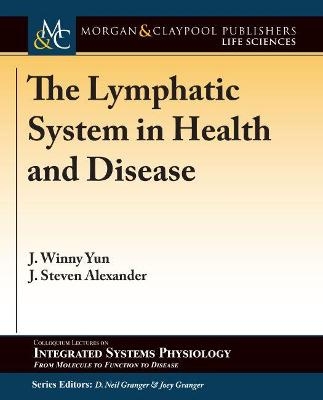
The Lymphatic System in Health and Disease
Morgan & Claypool Publishers (Verlag)
978-1-61504-791-8 (ISBN)
The lymphatic system develops and functions in parallel with the blood circulatory system (termed the "hemovasculature") and accomplishes transport of interstitial fluids, dietary lipids, and reverse transport of cholesterol, immune cells, and antigens—providing a critical homeostatic fluid balance and transmission of immune cells and mediators back to the cardiovascular system. Although the daily flow of lymph (normally 1-2 L/day under unstressed conditions) is far lower than that of daily blood flow (which is 7,500 L/day), without the adequate functioning of the lymphatics, virtually all organs and tissues would acutely suffer many different physical and inflammatory stresses ranging from edema to organ system failure. Although blood and lymphatic vessels often form in anatomic parallels to one another, our knowledge of the workings of the lymphatic system, the fine structure of lymphatic networks, how they function in different organs, and how they are regulated physiologically and immunologically are far from parallel; our knowledge of the lymphatic system still remains at only a tiny fraction of what is understood about the cardiovascular system. Although both the cardiovascular and lymphatic systems are important transport systems, what they transport and how they transport and propel these very different cargoes could not be more dissimilar.
This book provides an overview of the history of the discovery (and re-discovery) of the components of the lymphatic system, lymphatic anatomy, physiological functions of lymphatics, molecular features of the lymphatic system, and clinical perspectives involving lymphatics which may be of interest to scientists, clinicians, patients, and the lay public. We provide a current understanding of some of the more important structural similarities and differences between lymphatics and the blood vascular system, their coordinated control by angiogenic and hemangiogenic growth factors and other modulators, the fate and lineage determinants which control lymphatic development, and the roles that lymphatics may play in several different diseases.
J. Winny Yun is a PhD candidate in the Department of Molecular and Cellular Physiology at Louisiana State University Health Sciences Center-Shreveport. She received her BS from Johns Hopkins University in 2012. Her current research project focuses on understanding the roles of lymphatic proteins in brain endothelial cells and their microparticles in health and disease. She has been funded through the Annette Funicello Research Fund for Neurological Research and is a recipient of a fellowship from the Center for Cardiovascular Diseases and Sciences at LSUHSC-S. J. Steven Alexander, PhD, has been a professor in the department of Molecular and Cellular Physiology at Louisiana State University Health Sciences Center-Shreveport since 1994. He received his BA from Boston University in 1984 and his PhD in 1989. His current research project focuses on understanding the roles of lymphatic proteins in Alzheimer's disease, multiple sclerosis, and Parkinson's disease. He has more than 280 publications in the area of vascular/endothelial biology and has been continuously funded through NIH, DOD, and corporate and private funding since 1994. D. Neil Granger, Ph.D., is Boyd Professor Emeritus in the Department of Molecular and Cellular Physiology at the LSU Health Sciences Center in Shreveport, Louisiana. His research interests have been focused on the role of the microcirculation in acute and chronic inflammation and how risk factors for cardiovascular disease influence microvascular function. Dr. Granger has a longstanding record of teaching physiology to medical and graduate students. He has served on the editorial boards of the GI & Liver, Heart & Circulation, and Cell sections of the American Journal of Physiology, as well as Circulation Research, Microcirculation, Shock, Pathophysiology, Free Radical Biology & Medicine, Lymphatic Research and Biology, and Nitric Oxide Biology & Chemistry. He was an Associate Editor of the American Journal of Physiology: GI & Liver Physiology and the Editor-in-Chief of Microcirculation. Joey P. Granger, Ph.D., is the Billy S. Guyton Distinguished Professor, Professor of Physiology and Medicine, Director of the Center for Excellence in Cardiovascular-Renal Research, and Dean of the School of Graduate Studies in the Health Sciences at the University of Mississippi Medical Center in Jackson, MS. He earned his doctorate from the University of Mississippi School of Medicine in 1983. Dr. Granger served as President of the American Physiological Society and is an Associate Editor for Hypertension. He has also served as the Editor of the Council for High Blood Pressure Newsletter and an Associate Editor for News in Physiological Sciences and American Journal of Physiology. He has served as a member of Editorial Boards of American Journal of Hypertension, American Journal of Physiology-Renal, American Journal of Physiology: Regulatory and Integrative Physiology, Journal of CardioMetabolic Syndrome and the Journal of the American Society of Hypertension.
Preface
1. Introduction
2. Lymphatics in Different Organ Systems
3. Lymphatics in Pathophysiological States
4. Seminal Advancements and Future Directions
References
Author Biographies
| Erscheinungsdatum | 11.04.2019 |
|---|---|
| Reihe/Serie | Colloquium Series on Integrated Systems Physiology: From Molecule to Function to Disease |
| Mitarbeit |
Herausgeber (Serie): D. Neil Granger, Joey P. Granger |
| Verlagsort | San Rafael |
| Sprache | englisch |
| Maße | 152 x 229 mm |
| Gewicht | 333 g |
| Themenwelt | Studium ► 1. Studienabschnitt (Vorklinik) ► Physiologie |
| Naturwissenschaften ► Biologie | |
| ISBN-10 | 1-61504-791-3 / 1615047913 |
| ISBN-13 | 978-1-61504-791-8 / 9781615047918 |
| Zustand | Neuware |
| Haben Sie eine Frage zum Produkt? |
aus dem Bereich


